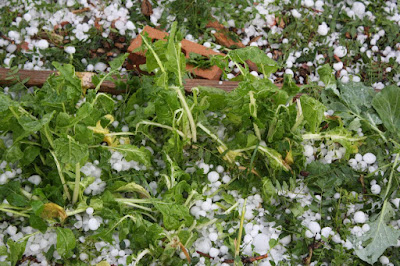 |
| Gravel mulch at Kendrick Lake Gardens in Lakewood |
[This blog was originally posted on March 18, 2014 and has been updated with new research-based information.]
The benefits of mulch are so well known that the question no
longer is “Should I mulch?” but “What mulch is best for my landscape?” For
die-hard gardeners, mulching is one garden task you can do any time of year –
even in the winter.
A mulch is any material that provides protection and
improves the soil when applied to the soil surface. Mulches can:
- reduce surface evaporation
- improve water penetration and air movement
- control soil temperature fluctuations
- protect shallow-rooted plants from freeze damage
- improve soil structure and nutrient availability
 |
| Small wood chip mulch around roses |
Your first decision will be deciding between organic and
inorganic mulch. According to PlantTalk Colorado, the most common organic
mulches in Colorado include wood chips, chunk bark, pole peelings, pine
needles, lawn clippings and straw. Organic mulches gradually break down and add
nutrients to the soil. Decomposition of fresh wood mulches can create nitrogen
deficiencies, so you’ll need to be prepared to supplement the area with a
fertilizer and replenish the mulch occasionally.
 |
| Gravel mulch at Kendrick Lake Gardens in Lakewood |
Inorganic mulches are stone-based and include rock,
cobblestone, pea gravel, lava rock and crushed rock. They store and radiate
heat, so avoid putting large areas of unshaded rock next to your house.
Regardless which type of mulch you choose, resist the urge
to install plastic sheeting or landscape fabric underneath the mulch. Air and moisture don't
penetrate plastic or fabric, so plant roots won’t develop but weeds will still come
through.
The selection of a mulch depends on its intended use. If
appearance is the main goal, inorganic or inert mulches may be the best choice.
If the main objective is soil improvement, consider an organic mulch that
gradually breaks down. If the area is used primarily for annual flowers, it
often is more practical to use a temporary organic mulch, such as composted
leaves or grass clippings that can be turned under each fall.
Mulches used to enhance appearance and control weeds may be applied at any time. Apply most mulches to a depth of 3 to 4 inches. Straw, dried leaves and similar materials can be applied to a depth of 4 to 6 inches. Around woody plants, push the mulch away so it isn’t touching the woody bark.
 |
Organic mulch from chipped Christmas trees
|
On the next visit in your garden, take a stroll through your landscape and consider where you can add mulch and take advantage of all its benefits. |
| Mulch can also be used for pathways |
For more information about mulches see the following:Mulches for Home Grounds:
https://extension.colostate.edu/topic-areas/yard-garden/mulches-for-home-grounds-7-214/
Xeriscape mulches: https://planttalk.colostate.edu/topics/water-wise-xeriscape/1905-xeriscape-mulches/
Organic mulches: https://planttalk.colostate.edu/topics/soils-amendments-composting/1609-organic-mulches/
Garden Notes: https://cmg.extension.colostate.edu/Gardennotes/245.pdf




















